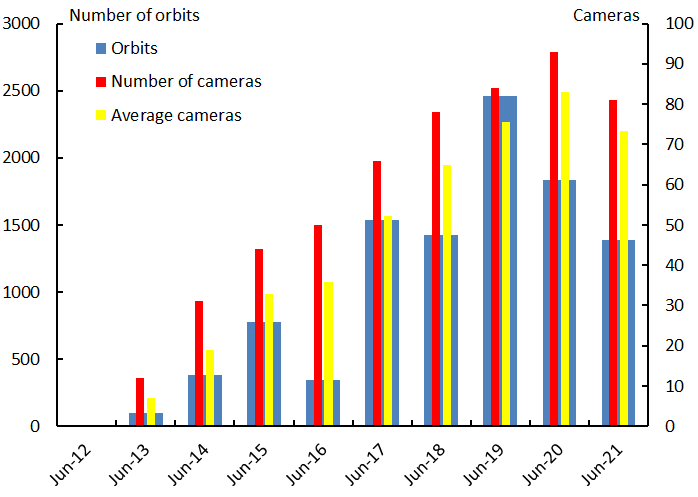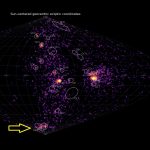Abstract: A summary of the activity of the CAMS BeNeLux network during the month of June 2021 is presented. 4347 multiple station meteors were captured which allowed to calculate 1389 orbits. June 2021 was the worst month of June since 2016.
1 Introduction
The last weeks of May and first weeks of June display very low meteor activity combined with short nights with between 7 hours and less than 6 hours of capture time. Therefore, no spectacular numbers of orbits are to be expected. Collecting orbits under these circumstances remains a challenge. What did June 2021 bring us?
2 June 2021 statistics
June is the most difficult month for CAMS BeNeLux because of the short observing window of barely 5 hours dark sky each night. The first half of June 2021 had a number of clear nights and several with partial clear sky. However, the second half of June came with exceptional poor weather, much too cold and totally overcast with a lot of rain. The worst possible weather pattern made astronomical observing almost impossible. As many as eight nights remained without any paired meteor (3 in June 2020). Three nights resulted in more than 100 orbits in spite of the short duration of these nights (against 8 in June 2020 and 13 nights in June 2019 when two nights scored more than 200 orbits). The best night for June 2021 was June 12–13 with 146 orbits. The statistics for June 2021 are compared in Figure 1 and Table 1 with the same month in previous years since the start of CAMS BeNeLux in 2012.
Table 1 – June 2021 compared to previous months of June.
| Year | Nights | Orbits | Stations | Max. Cams | Min. Cams | Mean Cams |
| 2012 | 0 | 0 | 4 | 0 | – | 0.0 |
| 2013 | 16 | 102 | 9 | 12 | – | 7.0 |
| 2014 | 23 | 379 | 13 | 31 | – | 19.0 |
| 2015 | 20 | 779 | 15 | 44 | – | 32.9 |
| 2016 | 18 | 345 | 17 | 50 | 15 | 35.7 |
| 2017 | 26 | 1536 | 19 | 66 | 30 | 52.1 |
| 2018 | 28 | 1425 | 21 | 78 | 52 | 64.9 |
| 2019 | 28 | 2457 | 20 | 84 | 63 | 75.6 |
| 2020 | 27 | 1833 | 24 | 93 | 60 | 83.1 |
| 2021 | 22 | 1389 | 26 | 81 | 54 | 73.3 |
| Total | 208 | 10246 |
While all CAMS stations in Belgium operate 7/7 with AutoCams, some of the Dutch CAMS stations still operate occasionally when the weather is clear. This way the coverage of the northern part of the network area isn’t as good as the southern part. For the coverage of the atmosphere by a camera network the chances for multiple station events especially during nights with variable weather depend on how many cameras are operational. When the weather happens to be poor but unpredictable like in June 2021, the only way not to miss unexpected clear sky is to have the camera systems running all nights, regardless the weather. To make the situation for June 2021 even worse some of the Dutch station were temporarily shut down for various reasons.

Figure 1 – Comparing June 2021 to previous months of June in the CAMS BeNeLux history. The blue bars represent the number of orbits, the red bars the maximum number of cameras running in a single night and the yellow bar the average number of cameras running per night.
During the best nights 81 cameras were operational (93 in June 2020 and 84 in 2019). Thanks to AutoCAMS at least 54 cameras were all nights operational (60 in 2020 and 63 in 2019). On average 73.3 of all available cameras were active, much less than the 83.1 of last year. The ratio of multiple station coincidences depends on the number of stations with clear sky during the same time span. The more stable the weather conditions are network wide and the less technical problems, the better the chances to catch a meteor from at least two stations.
The total number of orbits collected for the month of June reached 10246 in 208 nights of June that allowed to collect orbits. This way the month of June remains the poorest covered month of the year for CAMS BeNeLux, mainly because of the short duration nights.
Two RMS cameras produced the best scores in terms of orbits of all cameras in the CAMS BeNeLux network. There is no competition to nominate any most successful camera in the network, but in this case, it is interesting to see how the RMS performs compared to the Watecs. Certain cameras are pointed at regions where the chances for multiple station events is simply significant less, for instance towards the borders of the camera network coverage. However, to illustrate the order of difference for these RMS cameras, it is useful to compare these numbers with what the most successful Watecs obtained.
For the future of the CAMS BeNeLux network, the installation of extra RMS cameras will make the difference.
Table 2 – The ten cameras of the CAMS BeNeLux network with the best score in terms of orbits during the poor weather month of June 2021.
| Camera | Total orbits |
Total nights |
| Genk BE (RMS 003815) | 159 | 30 |
| Lesve BE (RMS 003816) | 158 | 30 |
| Dourbes BE (000394) | 119 | 30 |
| Mechelen BE (003891) | 115 | 30 |
| Mechelen BE (003836) | 103 | 30 |
| Mechelen BE (003837) | 101 | 30 |
| Uccle BE (000393) | 100 | 30 |
| Mechelen BE (003835) | 99 | 30 |
| Mechelen BE (RMS 003831) | 98 | 30 |
| Mechelen BE (RMS 003830) | 97 | 30 |
3 Conclusion
June 2021 was a poor month due to the very bad weather and to make things worse several CAMS stations remained temporarily unavailable. No surprise that June 2021 ended as the worst month of June since 2016.
Acknowledgment
Many thanks to all participants in the CAMS BeNeLux network for their dedicated efforts. The data on which this report is based has been taken from the CAMS website. The CAMS BeNeLux team was operated by the following volunteers during June 2021:
Felix Bettonvil (Utrecht, Netherlands, CAMS 376 and 377), Jean-Marie Biets (Wilderen, Belgium, CAMS 379, 380, 381 and 382), Ludger Boergerding (Holdorf, Germany, RMS 3801), Martin Breukers (Hengelo, Netherlands, CAMS 320, 321, 322, 323, 324, 325, 326 and 327), Guiseppe Canonaco (Genk, RMS 3815), Pierre de Ponthiere (Lesve, Belgium, RMS 3816), Bart Dessoy (Zoersel, Belgium, CAMS 397, 398, 804, 805, 806 and 3888), Tammo Jan Dijkema (Eelderwolde, Netherlands, RMS 3198, Dwingeloo, Netherlands, RMS 3199), Jean-Paul Dumoulin, Dominique Guiot and Christian Walin (Grapfontaine, Belgium, CAMS 814 and 815, RMS 3814), Uwe Glässner (Langenfeld, Germany, RMS 3800), Luc Gobin (Mechelen, Belgium, CAMS 3890, 3891, 3892 and 3893), Tioga Gulon (Nancy, France, CAMS 3900 and 3901), Robert Haas (Alphen aan de Rijn, Netherlands, CAMS 3160, 3161, 3162, 3163, 3164, 3165, 3166 and 3167), Robert Haas (Texel, Netherlands, CAMS 811, 812 and 813), Kees Habraken (Kattendijke, Netherlands, RMS 378), Klaas Jobse (Oostkapelle, Netherlands, CAMS 3031, 3032, 3033, 3034, 3035, 3036 and 3037), Carl Johannink (Gronau, Germany, CAMS 3001, 3002, 3003, 3004, 3005, 3006, 3007, 3008, 3009 and 3010), Reinhard Kühn (Flatzby, Germany, RMS 3802), Hervé Lamy (Dourbes, Belgium, CAMS 394 and 395), Hervé Lamy (Humain Belgium, CAMS 816), Hervé Lamy (Ukkel, Belgium, CAMS 393), Tim Polfliet (Gent, Belgium, CAMS 396), Steve Rau (Zillebeke, Belgium, CAMS 3850 and 3852), Paul and Adriana Roggemans (Mechelen, Belgium, RMS 3830 and 3831, CAMS 3832, 3833, 3834, 3835, 3836 and 3837), Hans Schremmer (Niederkruechten, Germany, CAMS 803) and Erwin van Ballegoij (Heesch, Netherlands, CAMS 348).






